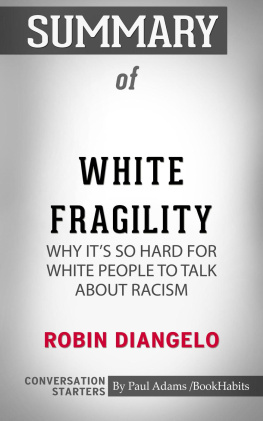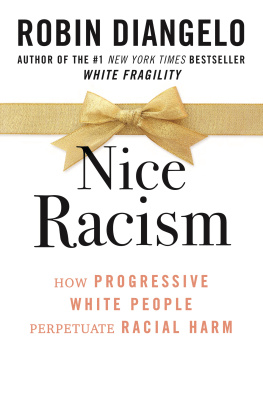Contents
Page List
Studies in the
Postmodern Theory of Education
Shirley R. Steinberg
General Editor
Vol. 497
The Counterpoints series is part of the Peter Lang Education list.
Every volume is peer reviewed and meets
the highest quality standards for content and production.
Robin DiAngelo
What Does It Mean
to Be White?
Developing White Racial Literacy
REVISED EDITION
Library of Congress Cataloging-in-Publication Data
Names: DiAngelo, Robin J., author.
Title: What does it mean to be white?: developing white racial literacy /
Robin DiAngelo.
Description: Revised edition. | New York: Peter Lang, 2016.
Series: Counterpoints: studies in the postmodern theory
of education; vol. 497 | ISSN 1058-1634
Includes bibliographical references and index.
Identifiers: LCCN 2016005919 | ISBN 978-1-4331-3110-3 (paperback: alk. paper)
ISBN 978-1-4539-1848-7 (e-book)
Subjects: LCSH: WhitesRace identity. | Race relations. | Racism.
Classification: LCC HT1575.D53 2016 | DDC 305.809dc23
LC record available at http://lccn.loc.gov/2016005919
Bibliographic information published by Die Deutsche Nationalbibliothek.
Die Deutsche Nationalbibliothek lists this publication in the Deutsche Nationalbibliografie; detailed bibliographic data are available on the Internet at http://dnb.d-nb.de/.
2016 Peter Lang Publishing, Inc., New York
29 Broadway, 18th floor, New York, NY 10006
www.peterlang.com
All rights reserved.
Reprint or reproduction, even partially, in all forms such as microfilm,
xerography, microfiche, microcard, and offset strictly prohibited.
ABOUT THE AUTHOR ( S )/ EDITOR ( S )
Robin DiAngelo received her Ph.D. at the University of Washington, where she was twice honored with the Students Choice Award for Educator of the Year. Her concept of white fragility has influenced the national discourse on race. She has published widely in both mainstream and academic venues.
ABOUT THE BOOK
What does it mean to be white in a society that proclaims race meaningless, yet is deeply divided by race? In the face of pervasive racial inequality and segregation, most white people cannot answer that question. In the second edition of this seminal text, Robin DiAngelo reveals the factors that make this question so difficult: mis-education about what racism is; ideologies such as individualism and colorblindness; segregation; and the belief that to be complicit in racism is to be an immoral person. These factors contribute to what she terms white racial illiteracy. Speaking as a white person to other white people, DiAngelo clearly and compellingly takes readers through an analysis of white socialization. Weaving research, analysis, stories, images, and familiar examples, she provides the framework needed to develop white racial literacy. She describes how race shapes the lives of white people, explains what makes racism so hard to see, identifies common white racial patterns, and speaks back to popular narratives that work to deny racism. Written as an accessible overview on white identity from an anti-racist framework, What Does It Mean to Be White? is an invaluable resource for members of diversity and anti-racism programs and study groups, and students of sociology, psychology, education, and other disciplines. This revised edition features two new chapters, including one on DiAngelos influential concept of white fragility. Written to be accessible both within and without academia, this revised edition also features discussion questions, an index, and a glossary.
Rarely will one find an analysis of whiteness (and the problems associated with it) that is as comprehensive as this one. From incisive and wide-ranging critiques of how white folks deflect, deny, and evade the topic of racism, and the implications of our own racial identity and position, to an absolutely on-point interrogation of how racism and whiteness influence white teachers-in-training, and thus, the larger educational process, Robin DiAngelo demonstrates the kind of clarity of thought so needed on this important subject.
Tim Wise, Author of White Like Me: Reflections on Race from a Privileged Son and
Dear White America: Letter to a New Minority
THIS EBOOK CAN BE CITED
This edition of the eBook can be cited. To enable this we have marked the start and end of a page. In cases where a word straddles a page break, the marker is placed inside the word at exactly the same position as in the physical book. This means that occasionally a word might be bifurcated by this marker.
This book is dedicated to Deborah Terry-Hays and Darlene Flynn, two of the most brilliant and committed leaders in the cause for racial justice I have ever known. You have been my mentors and guides on the most profound intellectual, emotional, and political journey of my life. Thank you for never giving up on me and for your immeasurable trust, patience, love, and support. To stand by your sides as a white woman in the struggle is the greatest of honors.
| ix
I extend my most heartfelt thanks to the numerous friends and colleagues who supported me in this project. Jason Toews, for the hours of astute and vigilant editing you generously donated; my colleagues Anika Nailah, zlem Sensoy, Holly Richardson, Carole Schroeder, Malena Pinkam, Lee Hatcher, William Borden, Kelli Miller, Ellany Kayce, Darlene Flynn, Deborah Terry, Jacque Larrainzar, Darlene Lee, Sameerah Ahmad, Nitza Hidalgo, and Kent Alexander for your support, insight, and invaluable feedback. Thank you Amie Thurber for your perceptive and detailed reading of the final draft and help with the discussion questions. Thank you Brandyn Gallagher for your insight and patience in working to raise my awareness of cis-supremacy. Thank you to Dana Michelle, Thalia Saplad, and Cheryl Harris for all I learned from you in the beginning of this journey.
Thank you to all of the scholars whose work has been foundational to my understanding of whiteness, particularly Peggy McIntosh, Richard Dyer, Charles Wright Mills and Ruth Frankenberg. Any errors or omissions in interpreting or crediting that work are my own.
A special thank you to Robin Boehlera fellow white allyfor the countless hours we spent debriefing our training sessions and working to put the racial puzzle together. Your support and brilliance were invaluable. ix | x
Thank you Todd LeMieux for all of your design and graphic work, Andrea OBrian for your Frames of Reference illustration, and Katherine Streeter for the beautiful cover art.
This text addresses whiteness within the context of what is now known as the United States, originally known as Turtle Island by some Indigenous peoples. The theft of Indigenous lands was the starting point of our current racial system. A key argument of this book is that we must know where we came from in order to understand where we are now. For a powerful overview of this history, see Bury My Heart at Wounded Knee and A Peoples History of the United States. In honor of the Indigenous peoples whose ancestral territories l stand on and write from, I offer my sincerest respect. x | xi














